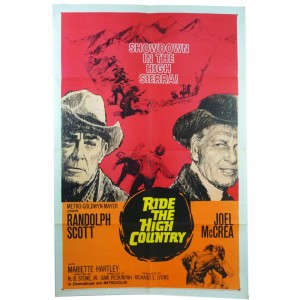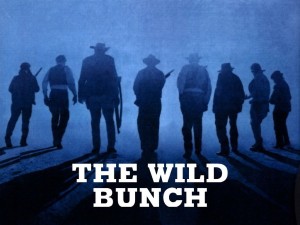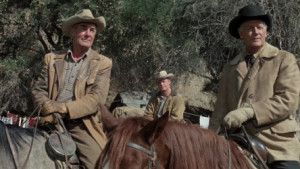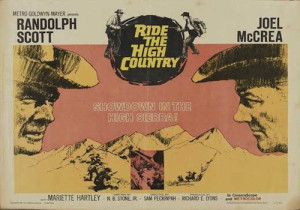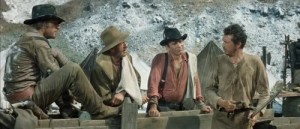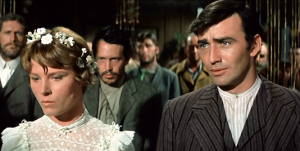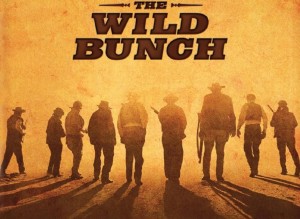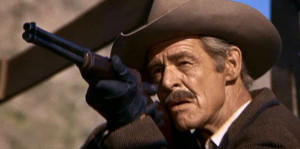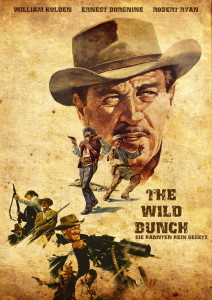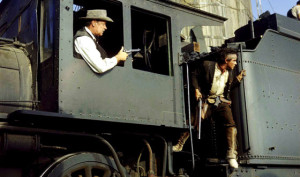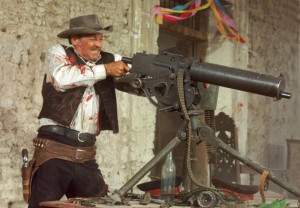“We’re not gonna get rid of anybody! We’re gonna stick together…When you side with a man, you stay with him! And if you can’t do that, you’re like some animal, you’re finished! We’re finished! All of us!
In both Ride the High Country (1962) and The Wild Bunch (1969), director Sam Peckinpah filters the most notable themes of his obsession through the prism of the genre best suited for their most powerful exploration: The Western. Those themes include man’s morally ambiguous nature in relation to an emerging civilization in the lawless wild, the changing landscaping threatening to leave the gunslinger an antiquated figure, and a man’s loyalty both to himself and fellow man that will often doom his remaining years. While the director would also notably venture into the crime and war genre, the Western remained the arena most ideally suited for his own dark interpretation of the West and its purpose as a crucible to challenge a man’s physical, moral, and psychological nature.
Ride the High Country follows the journey of former lawman Steve Judd (Joel McCrea). Though a former legend along the frontier, his career has devolved into that of a hired gun. Presently, Judd has been contracted to safely transport a shipment of gold from the Coarse Gold Mining Camp back to the town of Hornitos, California. After signing his contract (needing to hide in the bathroom with his reading glasses to do so), Judd runs into his old partner: Gil Westrum (Randolph Scott). Gil has now taken on the identity of a carnival huckster—using his sharpshooting skills to gain an easy buck while working with the hotheaded huckster named Heck Longtree (Ron Starr).
Gil convinces Judd that his and Heck’s help will make the dangerous trek more achievable—and though reluctant, Judd trusts the duo for their help delivering the gold. However, he remains unaware that Gil and Heck are actually conspiring against him – planning to steal the gold with or without his cooperation. On their first stop, they arrive upon an isolated farm ruled by the overbearing, religious man named Joshua Knudsen (R.G. Armstrong) and his daughter, Elsa (the film debut of Mariette Hartley). While the devout farmer criticizes the cowboys and their work in gold, his daughter yearns to flee from her isolated surroundings. Though she is promised to a miner at the Coarse Gold Camp named Billy Hammond, Heck remains determined to win her over.
After Joshua catches Heck and his daughter flirting under moonlight, the trio departs for Coarse Gold, until they are halted by the arrival of Elsa—having fled from her father and riding out to be married at the mining camp. Once again, Heck attempts to woo her—but his affections then steer dangerously close to rape before Judd stops him and promptly punishes Heck’s misbehavior. The young man accepts his punishment, though his relationship with Elsa grinds to a well-deserved stop.
Finally, the group arrives at the Coarse Gold Mining Camp, where Elsa finds her fiancé: Billy Hammond (James Drury), along with the rest of the Hammond Family. The brothers reveal themselves to be a crude and vile clan, who make their sexual designs toward Elsa undisguisably clear. Later, despite the aggressive behavior of Billy and his contemptuous clan, Elsa agrees to marry him in the town whorehouse that night. This harrowing, heartbreaking sequence allows for all the rituals of a wedding ceremony to be disastrously perverted by the confines of the whorehouse and its disdainful denizens, and Peckinpah never allows a moment of reprieve, as Mariette Hartley’s face floods with sorrow in being married by a town drunk with prostitutes serving as her bridesmaids.
Nonetheless, just minutes later, when Billy tries to rape her during their “honeymoon”, Elsa finally flees for help. Judd, Gil, and Heck come to her rescue—fending off the camp and rescuing Elsa out of her legally binding marriage. Though successful, this incites the wrath of the murderous Hammond clan. That night, realizing that Judd will never give up the gold, Gil conspires with Heck to finally steal the gold, but the latter has hesitations about betraying Judd – a man to whom he has grown fond and respectful. Gil follows through with the task, but Judd proves quicker on the draw—aware that this was a possibility, but dreading the thought of his old partner committing such a betrayal. Having shamed him, Judd then promises to have the two arrested upon their delivery of the gold.
The following day, they encounter the Hammond brothers and a gunfight ensues. Judd trusts Heck enough to free him during the gunfight, but they’re barely able to overcome the clan. Continuing their journey, Judd allows Gil to sleep on a promontory just out of eyesight, and the latter escapes. Nonetheless, Judd, Heck, and Elsa return to the girl’s farm, where they find her father has been murdered. The Hammonds ambush the trio, and Judd is shot in the gunfight.
Outnumbered and about to be massacred, Gil returns to the rescue at the last minute. They and the Hammonds agree to a fair and traditional shootout: the aftermath of which finds the Hammond clan dead and Judd on the verge of death. While Gil comforts his dying friend, Judd asks Heck and Elsa to stay away and not witness his agonizing death. Afterwards, Gil promises to deliver the gold, as Judd would have wanted. To which Judd replies: “Hell, I know that. I always did. You just forgot it for a while, that’s all.” Gil, Heck, and Elsa all walk away to deliver the dying wish, as Judd absorbs one final look at the Western landscape before falling to his death.
Elsa: My father says there’s only right and wrong – good and evil. Nothing in between. It isn’t that simple, is it?
Judd: No, it isn’t. It should be…but it isn’t.
As would be dealt with to an even more haunting degree in The Wild Bunch, Ride The High Country depicts men of a specific time recognizing that their world is quickly dissolving away in favor of a new kind of civilization—one whose advancement also engenders more ambiguous morals and motives. From the opening shot wherein Judd rides into Main Street believing that he is being greeted as a man of respectable legend, the town quickly pushes him aside in favoring of championing the hotheaded Heck and the shallow entertainment of his rigged camel races. Not moments later, he even runs into his old partner—Gil Westrum—now masked in a completely false identity to adapt with the times and conning the common man. Peckinpah further underlines the idea to more poignant effect when Judd arrives to sign his contract with the bank, and this hulking figure of masculinity must resort to hiding in the bathroom to withdraw his reading glasses– exposing a man all too aware of the new physical limitations accompanying his old age.
But despite his physical shortcomings , Judd remains a man of solid moral conviction and unwavering in his moral compass. Though he clearly discerns a shadow of evil lurking within his old partner, he wants to believe in the good still within Gil, even if that entails allowing his young, wayward sidekick to tag along for the task.
Peckinpah’s interest in exploring these murky morals are further explored in the confrontation between the dangerously religious Joshua and the treatment of his daughter, Elsa. Even with his proclivity for sententious preaching, Joshua’s cruel treatment of Elsa that escalates to physical abuse demonstrates another paradoxical realization of he West, when the motives of both state and religion served the purposes of those possessing its authority—an idea examined in even more stark terms upon their arrival in the mining camp.
On their journey there, however, Heck forces himself on Elsa—prompting Judd and Gil to humiliate him with physical punishment. While Heck and Gil are conspiring against Judd behind his back, this line of morality—of refusing to sink to these levels of depravity—help give further complexity to the very gray morality embedded within these characters and which will prove an important distinguishing factor between the young Heck and the vile Hammond clan.
When arriving in Coarse Gold, the darker aspects of the storyline finally come to full fruition. Hoping to spite Heck, Elsa remains adamant that she wishes to stay—and marry—Hammond, though the latter’s true insidious nature becomes quickly apparent: the brothers curse, behave cruelly, and treat the woman as an object of their lust.
While Peckinpah must contend with making a feature film within the boundaries of the ratings board and audiences of the early sixties, there are unsubtle clues that help hint toward the ugly intentions that inspire the Hammond clan. None more so than Billy himself, who comes dangerously close to raping Elsa just moments after their reunion, and causes Elsa’s anguish to turn from ironic to devastating. While Heck’s own assault is nothing more meritorious, Hammond represents an even more masculine brute—one whose odious nature destroys Elsa’s hope for a better life after escaping the suffocating grip of her tormenting father and has transformed her circumstances into a truly tragic tale.
The scene of the marriage ceremony itself produces even more stomach-turning results. The Hammonds hire the alcoholic mayor of the mining camp to officiate the ceremony, while the brothel serves as the church, and the local whores as Elsa’s bridesmaids. Again, Mariette Hartley’s face expresses the tragedy and perverted nature of this ceremony that was supposed to be the best day of her life in all its horrible agony, while Peckinpah never steeps to manipulative filmmaking affections in order to spell out the drama of the dire situation.
Instead, the terror of scene only worsens the following morning when realizing that—despite the awfulness of the Hammond Clan—Elsa is legally bound by marriage to Billy. While the cowboys promise to fight the decision, Heck vows to not leave unless she can be released from the terrible marriage—all too aware of the consequences in leaving her alone to contend with the sadistic Hammond Clan. Knowing that he will need Heck to overtake Judd in their conspiracy, Gil holds up the alcoholic officiator at gunpoint to steal and discard the license. In this one sequence alone, the story provokes a wide-ranging tapestry of the problematic morals engendered by the attempts to impose order upon an incipient civilization like that found at the mining camp—only for the gray morality of actual right and wrong to complicate matters so that even the best solution necessitates an immoral choice.
Though Gil has been painted as a mostly evil figure so far (Peckinpah going so far as to continually clothe him in devil-red pajamas while tempting Judd), the ultimate confrontation between the two former partners turns into a moment of cruel humiliation as the worst punishment. Judd tempts Gil to shoot him, but the betrayer cannot bring himself to actually shoot his old partner in cold blood. While Heck resigns to his arrest, Gil conspires to evade arrest and successfully does so when, once again, he takes advantage of Judd’s trusting disposition.
Now alone with Elsa and Heck to fend off the vengeful Hammond Clan, the trio are ambushed upon arriving back at the woman’s home front. Again, Judd has a moment of poignant recognition in realizing that he is not the invincible gunslinger that he used to be – as he has now endangered the lives of himself, the woman, and Heck, not to mention the loss of the gold that he promised to deliver. Outnumbered and on the verge of defeat, the climactic return of Gil provides a very well-deserved emotional climax that has come after Peckinpah has so firmly constructed a portrait of Gil’s corrupted character. Now reunited and on the same side, the two partners convince the Hammond clan to a traditional gunfight – the last of a respected ritual that these men of the west will practice.
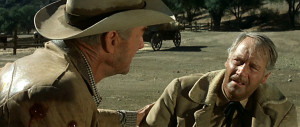
While they are ultimately successful, Judd is mortally wounded in the shootout and prepared to die. He falls to the ground and begs to die alone in his weakest moment. Gil (with Heck’s help) promises to honor Judd’s wishes—allowing the formerly corrupt conspirators to come full circle in following the right choice—though at the cost of Judd’s death. The surviving trio returns to the task of delivering the gold back to Hornitos, while Judd—now alone and resigned—turns for one last look at the placid mountain behind him—a symbolic monument to his own former physical stature and unchanging moral compass—before collapsing to die.
Ride the High Country represents a story set on the Western range that exemplifies ideas of a man’s compromised morals that would come to be a defining feature in Peckinpah’s filmography. That is to say, that no outcome would ever yield success while being able to accomplish both the morally right decision and the successful execution of the goal. While Judd represents the unwavering moral compass indicative of the legendary gunslingers of old, the ugly complications wrought by a society attempting to impose order on a barbaric land results in either his own death or the corruption of his or companions’ moral code. Although Ride the High Country features compelling, distinct characters that serve to illuminate these themes in the director’s dark vision of the West, his most famous film would cement these ideas to even more profound effect and contribute to the most defining feature of his career in the form of 1969’s The Wild Bunch.
While Ride the High Country offers an entertaining and sentimental impression of those themes and characters that would populate the Peckinpah western, The Wild Bunch serves as the ultimate expression of Peckinpah’s storytelling sensibilities by subverting typical genre expectations to deliver a harrowing and haunting narrative magnified by its revolutionary techniques in craft. Though Leone explored similar territory in his examination of outdated men confronted with a gray morality in his own magnum opus—Once Upon A Time in the West—released just a year prior, Peckinpah’s The Wild Bunch shows an ugly, brutal side to the oater genre that focuses more on the interior psychology of these doomed men—complemented by its revolutionary editing techniques—to offer a more poignant and morally ambiguous portrait than can be found in its genre predecessors.
In an image that recalls the opening of Cluzot’s The Wages of Fear —featuring young children cruelly toying with scorpions—the opening sequence sets the tone for the unapologetically rough ride ahead. Though opening a western with the stickup of a local bank may seem standard enough, Peckinpah quickly deconstructs the characters and opening set piece into a sequence much more startling than audiences could expect. Having slowly established the peaceful town setting, the bloody bank shootout descends into an ugly massacre that costs the lives of innocent men, women, and children in the service of a bank heist set-up in which neither side is victorious and only foreshadows the blood to be shed by both sides of the law by the finale.
The apparent protagonist—William Holden’s Pike—introduces his character with the famous opening line: “If they move, kill ‘em”, and his decision to sacrifice an innocent female bystander as a human shield only cements the ugly truth about this leader’s difficult moral center from the start. Peckinpah portrays the shootout itself in an explosive, chaotic nature meant to disrupt typical audience expectations of the noble cowboy gunfight that works to overwhelmingly visceral effect—inflicting the audience with a similar sense of surprise and turbulence experienced by the characters.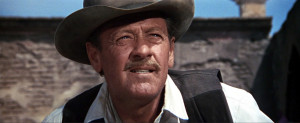
Although obviously operating under very different intentions, Peckinpah’s feverish vision of the gunfight that so harshly clashes against those versions pioneered by Leone and Ford deserves especial consideration. While the grandiose nature of the genre normally elevated these cowboys to the ranks of aspirational heroes (often more so for the outlaws), Peckinpah’s provocative opening instead depicts the cold brutality that constitutes these gunslingers. While Pike seems to be living under the philosophy of kill-or-be-killed, his subordinate—Crazy Lee—is shown to be a true psychopath: a man reveling in the cruelty and authority of the gun, and whose careless pleasure for the lifestyle costs him his life. A sad fate filled with even more consequence when it’s later revealed that he is the grandson of the elderly gang member Sykes. While Arthur Penn’s Bonnie and Clyde (1967) had first set the stage for this level of explosive violence and emboldened Peckinpah to further pursue his revisionist genre depiction, the brutal bloodshed within this opening sequence stands as a perfect encapsulation of the complicated morality found within the characters and the harrowing style meant to mirror the ugly savagery of the setting.
Though the gang escapes, the introduction of Pike’s former partner turned pursuer in the form of Robert Ryan’s Deke Thornton further complicates the relationship at play between cop and robber. As Deke has been threatened with either capturing Pike or being returned to a Yuma prison for torture, Deke recognizes that—although The Wild Bunch are no heroes—there is perhaps an even more insidious evil lurking beneath the motives of the railroad and their deputizing the equally lawless bounty hunters to capture them for profit (a premise explored at length in Corbucci’s The Great Silence). Though Deke demonstrates his own inner conflict at being forced to hunt down his friend, he does not hide his disgust at the gleeful behavior of the bounty hunters authorized to kill within the boundaries of the law.
Deke’s disgust becomes even more apparent in the aftermath of the shootout—and begins a motif seen continually throughout the film—wherein children reenact the witnessed violence of the outlaws and authorities. Rather than comprehend the horror of the carnage (with the corpses of their fellow citizens still lying about them), the children engage in imaginary shootouts with one another that further underlines the idea of children inheriting this violence without understanding its terrible cost to their burgeoning civilization.
Back with the Wild Bunch, in the aftermath of barely surviving the shootout, an undercurrent of acknowledgement that their days are undeniably numbered begins to emerge—no one more cognizant of this fact than Pike himself. Without time to mourn or bury their dead, and humiliated with the reveal of the silver washers instead of the silver cache that was meant to be their final steal, William Holden’s face exposes all the heartbreak that now defines this doomed gunslinger.
Faced with no other choice but move forward, he reasserts that the one element within their of control for survival and most distinguishing principle between themselves and the corrupted bureaucracy around them lies in the trust held between each gang member. He orders:
“We’re not gonna get rid of anybody! We’re gonna stick together…When you side with a man, you stay with him! And if you can’t do that, you’re like some animal, you’re finished! We’re finished! All of us!”
There’s a desperation and honestly in voices that shades him with virtues of honor—reinforcing the fact idea that the moral quagmire within these characters remains much more complex than can be normally ascribed to the characters that often inhabit the Western genre.
During this brief pause, along with one that occurs a bit later, flashbacks into Pike’s past provide important context on the episodes responsible for informing this broken man’s past both personally and professionally. A flashback into an affair with a Mexican woman that concludes in her being murdered and Pike being shot offers a glimpse into the sorrow and regret drowned by his continual drinking and bloodshed. More importantly, it demonstrates an attempt by the outlaw to change his lifestyle—only for the return of violence to deprive his happiness and dictate his return to the former gangland lifestyle. Though expository, it’s an interesting moment that further fleshes out this character in the hopes of distinguishing him from the typical criminal by offering yet another layer in the complicated, three-dimensional psychology of this protagonist.
Moreover, his flashback with Deke further enriches the relationship between these two men now on opposite sides of the law. The flashback depicts a time during their partnership where the normally cautious Pike felt confident enough to drink, socialize with the women, let down his guard, and which led to Deke’s subsequent arrest. Though short, this flashback also imparts vital character information into Pike’s haunted past that fuels his now unwavering principles of loyalty—as will be seen later with Angel—as he knows the anguish of betraying this principle and the terrible toll upon his conscience. Not to mention, the fact that it has literally come back to haunt him—as Deke now stands as his biggest antagonist and source of his setbacks.
After crossing into Mexico and settling into Angel’s village, the gang enjoys the momentary respite and feeling of community long absent in their time on the other side of the border. As Pike listens to the village’s struggles against the corrupt Mapache, and saturates himself in the simple pleasures of life, he’s reminded of a poignant quote by Don Jose that triggers Pike’s more tender side: “We all dream of being a child again, even the worst of us. Perhaps the worst most of all”. While Pike watches the women and children within their calm paradise, the quote takes on an even more heartbreaking power when considering Angel’s brutal fate soon to come. Nonetheless, the scene still allows the gang a night of temporary joy—a moment to dance, laugh, and enjoy the sheer camaraderie of being outlaws—a moment of bliss that will ultimately be one of their last.
For after the gang moves on from their stay in Angel’s village into Mapache’s dominion of Agua Verde, Angel quick destroys any chance of goodwill or anonymity by attempting to kill his former lover for holding an affair with Mapache – a gunshot that errs dangerously close to assassinating Mapache himself. While this incident services a critical plot point by involving the gang into the ammunitions heist, it also functions as a moment of important character illumination; specifically, as seen with Pike. For although the gang leader has been established as one ruthless enough to use a woman as a human shield to survive a shootout, he refuses to compromise his men and accepts the dangerous task directed by Mapache—a vitally important moral decision that will distinguish him from Dutch’s actions involving Angel and Mapache at the climax that will ultimate cost their lives.
Though the gang indulgences in all the pleasures of the flesh before their final heist, these satisfactions suggest a very different kind of joy from the state of contentment seen in Angel’s village. Instead, this is a joy akin to a man eating his last meal on death row. The gang drinks, wallows in alcohol with the women, relaxes—and though Peckinpah films this sequence intending to allow the audience to revel in the bacchanal festivities—a lingering sense of discontentment hangs over these aged men enjoying one last romp before their last battle.
The gang’s robbery of the train and subsequent escape with the ammunition boxes composes the majority of the middle and displays another example of Peckinpah’s impeccable ability to merge major thematic ideals with compelling cinematic techniques. The heist unfolds with slow, deliberate pacing that allows for the all the tension of the scene to hold its grip without ever breaking into rapid-cutting or becoming fearful of the extended time that its numerous machinations demand to construct an escalating sequence of suspense. Every single character’s action and purpose is carefully choreographed, and while the viewer remains gripped by the actual execution of the heist, the lack of score additionally enriches the tension by imbuing atmospheric details—the chugging of the train, the screeching brakes, the panicked whispers between the crew, the distant hoof beats—that all work in service of this precisely paced set-piece.
Simultaneous to this occurrence, Deke realizes that the train is being robbed and frantically attempts to catch his old partner. While gathering his posse, he surveys the various compartments to find fresh faced boys sporting their uniforms that he instantly realizes will have no chance against the ruthless Wild Bunch. While most filmmakers would feel the need to belabor the internal debate of Deke’s dilemma, Peckinpah merely cuts between Robert Ryan’s exasperated expression and the excited or bored expression upon the faces of the adolescent soldiers.
After losing Deke in the bridge explosion crossing the Rio Grande, Pike keeps his word to Angel and releases one of the ammunition cases for his people in the fight against Mapache. Nonetheless, the gang also devises a careful plan for themselves by releasing the cases in separated deliveries that will ensure they receive their full payment without being double-crossed or killed. Pike also supplies Mapache with an (anachronistic) M1919 Machine Gun as a sign of good faith—much to the joy of his surrounding generals. While the plan starts out smoothly, during one of the final deliveries led by Dutch and Angel, Mapache learns of the missing shipment gifted to Angel.
Though Angel initially denies it, Dutch succumbs to his fear of losing the gold or his own life and gives up his companion. Afterwards, the gang recognizes that they are quickly running out of options: Deke is dangerously close on their tail—having already shot Sykes—and they don’t have enough resources to travel out of range: necessitating their return to Agua Verde for safety. Upon arriving, Pike is greeted by the horrendous sight of Angel’s torture—being dragged around town by a rope around his neck attached to the rear bumper of Mapache’s car. Soldiers, women, and children take turns mocking and humiliating him, while his face has been deformed into a bloody pulp. Without any options, Pike and the gang can only absorb the sight with utter disgust. Pike watches with repulsion across his face and can only murmur: “God, I hate to see that.”
While the town of Agua Verde continues their Caligulan celebration, the gang spends their remaining moments in desolate contemplation. Though both Pike and the Lyle twins are with prostitutes, their attention is clearly focused on the horrendous sight seen riding in town. Knowing the right thing to do, Pike gathers Dutch and the brothers together with a simple, “Let’s go” and seals their collective fates. The boys then gather their weapons and begin their final, iconic walk to confront Mapache. Although the moment was unscripted, Peckinpah frames this last stand with a sense of nobility toward the dreaded outcome. These are four doomed men walking toward their grave in an effort to save their friend, and Peckinpah allows the moving emotion of this effort to be diffused upon the viewer to powerful effect.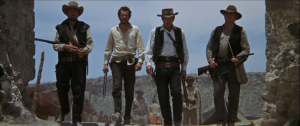
Upon requesting that they want Angel back, the vicious leader acts about as can be expected—and brutally slices Angel’s throat in defiance of their demand. Having already committed to their decision, Pike wastes no time removing his pistol and shooting the General—knowing full well the consequence of certain death in doing so. While the other leaders remain so momentarily stunned that the gang manages to kill a few of them too, the plaza soon turns into another all-out-war-zone with the Wild Bunch very much outnumbered.
While the opening bank shootout providees a glimpse into the explosive violence that would become a defining feature of the film’s legacy, the last shootout in the plaza—with Pike firing the machine gun in a blaze of glory until his final breath—stands as a true testament to the kind of visceral and revolutionary cinematic techniques on display. This is not the operatic violence of Leone, nor the noble cowboy ritual observed by Ford, but a gruesome cacophony of bullets being fired by men as desperate as cornered animals.
Despite firing back at the army with all their courage, the gang slowly succumbs to their inescapable deaths. Though Pike spares a woman hiding a soldier, she delivers the first bullet that will bring him down. Moments later, after surviving a hail of bullets, a shot in the back from a small child proves to be the final straw that kills this legendary outlaw—another subtle comment on the pervasive violence of the West often absent from most films of the genre which usually confine the violence to the domain of cowboys and brigands. It is not the expected adversary of Deke or Mapache that kills this protagonist, but the women and children whose lives he previously spared that show no mercy in preserving Pike’s own tradition of kill-or-be-killed.
Amidst the rapid-fire of bullets replicated in the quick-paced shots of the editing, Pike’s death and the individual deaths of the Bunch play out in grueling experiences meant to overwhelm the audience. Their pained facial expressions, the jolt of their bodies, the agony in their eyes—all distilled to impose their dramatic effect upon the viewer without ever drowning the emotion to the point that it becomes numbing or melodramatic in the midst of the chaotic gunfire. Instead, the viewer feels the various deaths while caught up in the thrill of the sequence—leading to a powerful, explosive climax that remains as harrowing as it is heartbreaking.
No moment more heartbreaking, however, then what follows in the epilogue. In the wake of this massacre for both sides, Deke and his posse of bounty hunters finally catch up with the elusive gang. They are joined by women, children, and buzzards perched upon the stone gates overlooking their fresh supply of corpses. The juxtaposition between the simultaneous arrival of the ravenous animals and Deke’s men demonstrates the clear parallel between these animals hoping to salvage the corpses for their own selfish needs and these bounty hunters hoping to accomplish much of the same.
And thought Deke’s deputized men howl with glee, Deke stares down at Pike’s corpse—his former friend’s body pitifully slumped over the machine with his fingers still wrapped around the trigger—and a devastated expression washes over his features. A kind of devastation that Peckinpah has articulated time and again throughout the narrative but wisely leaves absent in this specific moment: that these are men who could not think beyond their guns, who died by their principles of loyalty to one another, and who would not break their own code to conform to the changing civilization around them.
Despite his companions’ glee in salvaging the corpses, Deke recognizes that Pike’s death is the end of a era—an end of the West and the kind of men who died by a code that he himself recognizes and honors—and now belongs to the buzzards that are working beside him at the behest of the railroad and bureaucratic civilization. Afterward, not seeing Sykes corpse amongst the Bunch after having knowingly shot him earlier, Deke allows the posse to ride ahead while he remains at Agua Verde to contemplate his future. When distant gunshots confirm his suspicions that the posse has met with Sykes and his recruited rebels, a subtle smile emerges from Deke’s face. Not much longer, Sykes and his own new posse ride into town to greet the former estranged member of the gang:
Sykes: I Didn’t expect to find you here.
Deke Thornton: Why not? I sent them back; That’s all I said I’d do.
Sykes: They didn’t get very far.
Deke Thornton: I figured.
Sykes: What are your plans, now?
Deke Thornton: Drift around down here. Try to stay out of jail.
Sykes: Well, me and the boys got some work to do. You want to come with us? It ain’t like it used to be; but it’ll do.
The dialogue concludes with Deke mounting his horse and joining the new posse: having justified within himself that he’d rather die a man like Pike – a man who confronted death on his own terms and out of an unbreakable code to his friends —rather than a slave to the system in some Yuma prison. With Sykes and himself now the two remaining members, and knowing that the end is near, Deke still understands the significance of dying in the pursuit of honor—even if that means riding as a member in the infamous outlaw gang known as The Wild Bunch.
The Western has always provided perhaps the best canvas for storytellers to impose their broader obsessions of moral ambiguity due to the genre’s general setting of a burgeoning society attempting to civilize a lawless terrain. In both Ride the High Country and The Wild Bunch, Peckinpah offers his own allegorical interpretations of the West and its issues of masculinity, loyalty, and a very gray morality. As Ride the High Country offers a very entertaining and compelling variation upon these typical genre tropes, The Wild Bunch stands as one of the most impressive examples—not only in Peckinpah’s filmography but the genre at large—of how these thematic ideas can be explored in both narrative and craft to exceptional and illuminating results within the Western.
